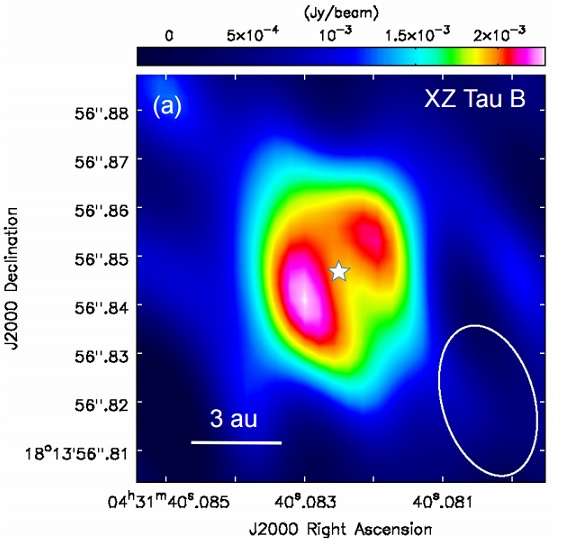June 14, 2016 weblog
Dwarf protoplanetary disk detected around distant young star

(Phys.org)—A dwarf transitional protoplanetary disk was found around the young star XZ Tau B, located some 460 light years away. According to a research paper published online on June 9 on arXiv.org, this disk of dust is much smaller than ordinary disks observed around other stars. The newly discovered feature could be a testbed for future studies regarding the evolution of transitional disks as it showcases attributes characteristic for these objects but on a much smaller scale.
XZ Tau B is a 4.6-million-year old M2 dwarf star in the L1551 molecular cloud. It is slightly bigger than our sun with a radius of about 1.24 solar radii, but less massive as it has only 0.37 solar masses. The star composes a triple system together with the close pair XZ Tau A/C.
In late 2014, a team of astronomers led by Mayra Osorio of the Institute of Astrophysics of Andalusia in Granada, Spain, has used a set of 42 antennas at the Atacama Large Millimeter Array (ALMA) in Chile, to conduct observations of XZ Tau B. The scientists noticed that this star is a source of a dust emission, forming what appears to be a transitional protoplanetary disk.
In order to confirm the presence of a disk around XZ Tau B, the team carried out a detailed modeling of the spectral energy distribution. The observations and the model developed by the researchers, allowed them to derive fundamental parameters of the disk.
According to the research, the disk has a relatively small radius and is one of the less massive ever found. Its inner radius is about 1.3 AU, while the outer radius was found to be 3.4 AU. The disk's total mass derived from the model was calculated to be approximately nine times greater than the mass of Jupiter.
"Since we are interested in studying the capability of the disk to form planets, we have selected the model that fits the data with the highest allowed value for the viscosity parameter, which gives the lowest disk mass of nine Jupiter masses," the scientists wrote in the paper.
In comparison, typical transitional disks imaged so far have radii ranging from 50 to 100 AU and masses of 10 to 100 than that of Jupiter.
Trying to explain the small size of the disk around XZ Tau B, the scientists have offered few hypothesis to resolve this issue. They noted that the disk could be originally small or that simple tidal truncation models might not apply for the particular geometry of this disk and truncation occurs at a smaller scale. Other possible explanations are that the disk is outwardly truncated by a forming planet in an outer orbit or that the outer parts of the disk have been removed by other mechanisms, for instance swept out by the sequence of expanding bubbles from other stars in the system.
Transitional disks like the one around XZ Tau B, are type of accretion disks that present central cavities and annular gaps in their dust emission that have been attributed to the effects of tidal interactions of orbiting planetary or protoplanetary bodies. They are believed to be signposts of the planet formation process and they could deliver crucial information on this topic.
Therefore, XZ Tau B, and also other similar dwarf disks, may serve in the near future as valuable small-scale models for a fast and efficient study of the evolution of transitional disks.
"XZ Tau B opens a new window to investigate with ALMA observations the disk evolution and first stages of planet formation on time-scales and at radii that so far remained unexplored," the team concluded.
More information: A Dwarf Protoplanetary Disk around XZ Tau B, arXiv:1606.03118 [astro-ph.SR] arxiv.org/abs/1606.03118
Abstract
We report the discovery of a dwarf protoplanetary disk around the star XZ Tau B that shows all the features of a classical transitional disk but on a much smaller scale. The disk has been imaged with the Atacama Large Millimeter/Submillimeter Array (ALMA), revealing that its dust emission has a quite small radius of ~ 3.4 au and presents a central cavity of ~ 1.3 au in radius that we attribute to clearing by a compact system of orbiting (proto)planets. Given the very small radii involved, evolution is expected to be much faster in this disk (observable changes in a few months) than in classical disks (observable changes requiring decades) and easy to monitor with observations in the near future. From our modeling we estimate that the mass of the disk is large enough to form a compact planetary system.
© 2016 Phys.org





















